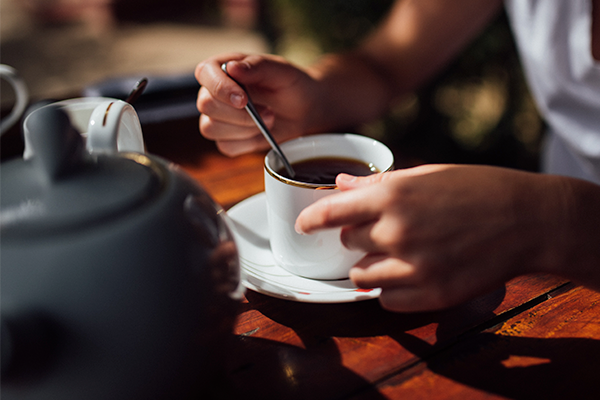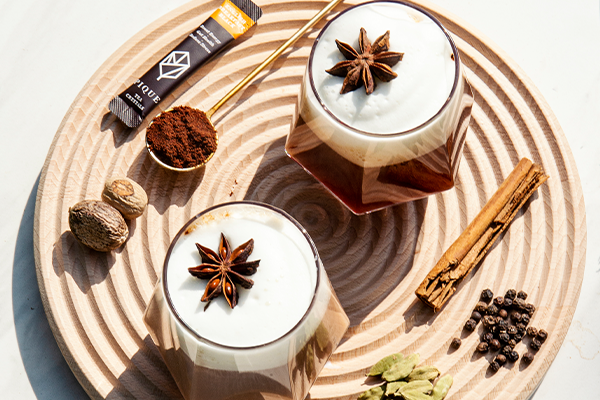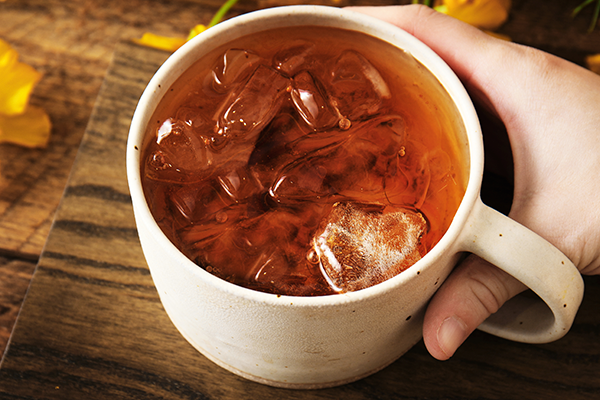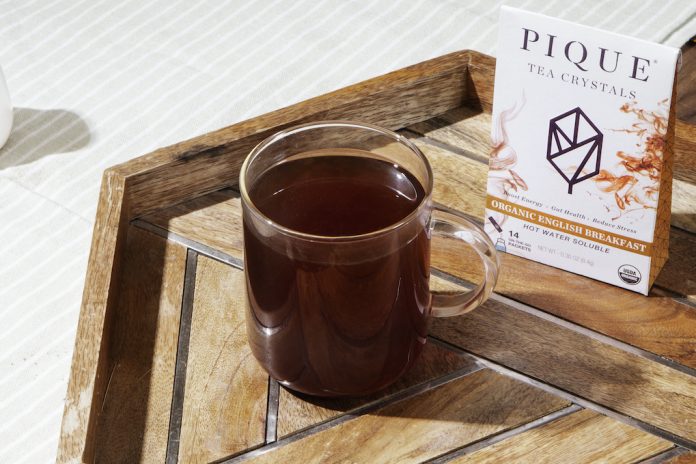In the mid-1800s, Scottish explorer James Taylor brought a tea plant into Kandy, a province in the central highlands of Sri Lanka – then called Ceylon.
From that one plant, he began to cultivate a small plantation and eventually began selling tea to other regions and other countries. Thus the Sri Lankan tea industry – and Ceylon Tea – was born [1].
Today, tea plantations cover roughly 5% of the country’s land, and much of the population works in the industry in some way [1]. Tea isn’t just one of Sri Lanka’s most profitable exports – it’s also a cultural drink enjoyed by citizens several times a day.
To them, a cup of tea is as natural and necessary as drinking water.
If you’ve ever wondered what sets Ceylon apart from other types of tea or why you might want to drink it, we’ve got the details for you here.
What is Ceylon Tea?
Today “Ceylon tea” refers to any tea grown and produced in Sri Lanka.
It comes from the Camellia sinensis plant that is the parent of all true teas. Ceylon teas can be produced as black, oolong, green or white tea — though black tea is predominant.
Even within each type, however, the flavor and aroma of Ceylon tea can vary significantly depending on where it was grown. Sri Lanka’s topography is speckled with both high peaks and low valleys. If you’ve ever gone hiking in the mountains, you know just how much the climate can change from the base to the summit.
Tea can grow all along the elevation grade, but differences in temperature and moisture do have an effect on the final taste. At higher altitudes in central Sri Lanka, humidity and rainfall are persistent but the air remains cool. That environment tends to produce a lighter flavor, while low-grown teas have a richer, more full-bodied taste. [2]
Perhaps the most highly-regarded growing region in Sri Lanka is the Uva highland region. Strong winds common to the area cause the tea leaves to dry and close up, resulting in a copper-colored tea with a smooth, mellow taste and enticing aroma.
Although the taste of Ceylon tea depends on its region, its characteristic flavor profile is generally lighter than a traditional Chinese black tea, with a slightly sweet, citrusy aroma. [2]
How Ceylon Tea is Made
Ceylon tea leaves tend to be longer, thinner and stiffer than their Chinese cousins. Because they can become tough more quickly, they need to be harvested more often and picked while they are still soft. Tea pickers might scour their fields for fresh leaves every seven to 14 days. [3]
Once picked, the teas are ‘withered,’ or dried out, and then twisted. Twisting the leaves helps to release and activate enzymes that kickstart the oxidation process. Oxidation is a critical step in the production of black tea.
The longer a tea oxidizes, the more it loses its astringent properties and mellows out in flavor, resulting in a smoother mouthfeel.
Black teas can oxidize (or ferment) for as long as several months to create a more complex flavor, but oxidation of Ceylon black tea usually lasts about a week. [3] It’s then roasted to stop the oxidation process and bring out the leaves’ natural sweetness.
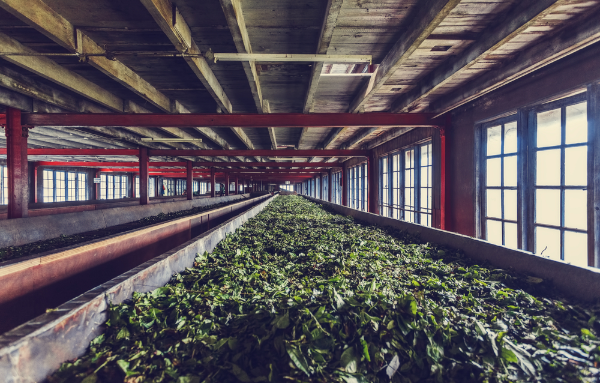
How to Drink Ceylon Tea
Ceylon may well be the most versatile of tea types. Because of its lighter flavor, it’s popular as a refreshing iced tea, either enhanced with lemon and sugar or enjoyed on its own. Similarly, as a hot tea, drinkers are as likely to add milk and honey to their brew as they are to sip it straight. [4]
Because of how well it pairs with dairy and sweetener, Ceylon is sometimes added to English breakfast teas. [4] Most English breakfast teas are made predominantly with Assam, a black tea from India that carries a very rich and robust flavor — a perfect wake-up beverage. The addition of Ceylon helps to round out Assam’s boldness and creates a milder flavor.
Ceylon also makes for a great breakfast beverage because of its amount of caffeine. One 8-ounce cup can contain up to 60 mg of caffeine. [5]
A standard cup of coffee by comparison generally has about 95 mg of caffeine. Ceylon black tea or English breakfast tea can be great alternatives for those who still want a caffeine boost in the morning but are looking to pare down their overall intake.
Health Benefits of Ceylon Tea
1. Caffeine Content
Caffeine is just one component of Ceylon black tea that contributes to its nutritional profile. Several studies have found that caffeine may help to support healthy blood sugar levels and therefore promote overall health. [6][7]
It’s important to be aware of caffeine’s negative side effects as well, including increased risk for anxiety and insomnia. Moderation is always key, and it’s best to avoid caffeine in the late afternoon and evening hours. [6]
2. Polyphenol Content
Like all true teas, Ceylon is packed with polyphenols and other antioxidant compounds. [8] Remember the oxidation process described above? That process actually takes the polyphenols found in green teas (also known as catechins) and converts them into different polyphenols: theaflavins and thearubigins.
Theaflavins and thearubigins are unique to darker teas, and they carry unique health benefits [9]. For example, they function as prebiotics, helping to support good gut health. [10]
Plus, polyphenols (antioxidant compounds) in general have well-studied and documented health benefits. By helping to halt oxidative damage to cells, polyphenols (and all antioxidants) may help to support overall health and longevity. [11]
3. Help for Healthy Weight Management
Studies also suggest that drinking tea regularly can aid in healthy weight management. Some compounds have been shown to block the absorption of fat and speed up metabolism, and regular tea drinking has been associated with lower BMI. [11]
If you’re interested in tea for weight management, you should know that most studies that indicated weight loss did not control for other lifestyle factors like overall diet or physical activity patterns. In all, these studies suggest that tea can be helpful in efforts to maintain a healthy weight when included in a balanced diet along with regular exercise.
How to Brew Ceylon Tea
To bring out Ceylon’s bright, citrusy notes, proper brewing is crucial. Taking the time to get the details right will yield the most flavorsome cup of Ceylon tea.
To start, make sure to use clean, filtered water. Most tap water is fortified with small quantities of minerals like magnesium and fluoride. Even at low concentrations, these substances may interfere with the tea’s true flavor. [12]
The next step is preheating your cup. Before dropping your tea leaves into the hot water, pour some into your mug and let it heat the interior as your tea seeps. This will prevent your drink from cooling down too quickly.
For Ceylon black tea, it’s okay to bring the water all the way to boiling. More delicate green and white teas often can’t stand up to such hot temperatures, but black leaf teas are robust, and hotter water helps to release their layers of flavor and aroma.
For every 8 ounces of hot water, use about one teaspoon of tea leaves. Let them steep for about two minutes. If you plan on adding milk and sugar, steep for an extra minute to bring out a bolder flavor that won’t be diluted by your additions. [12]
Stir the leaves around a bit as they steep. If they settle on the bottom, they may not fully unfurl. A good stir helps the water to extract flavor from the leaves’ entire surface area. This won’t be necessary if you’re using tea bags, but loose leaves generally deliver better taste and aroma.
Storage matters too. Tea leaves can absorb moisture and odors from the air, and exposure to light can further oxidize them, altering their flavor. To preserve the quality of your leaves, keep them in an airtight container in a cool, dark place.
The Final Sip
Ceylon black tea is best enjoyed as a morning brew thanks to its caffeine content, and because its bright notes help to balance the darker, roasty flavors of other black teas commonly found in English breakfast blends. A powerful dose of antioxidants also confers an array of health benefits, making Ceylon both a tasty and healthy way to start your day.
No worries if you can’t book a flight to Sri Lanka. In 2019, the country exported nearly $1 billion worth of Ceylon tea to nations all around the globe. To identify high-quality tea, look for the Lion Logo. Owned by the Sri Lanka Tea Board, the logo signifies 100% pure Ceylon tea leaves that meet their stringent quality standards. [13]
